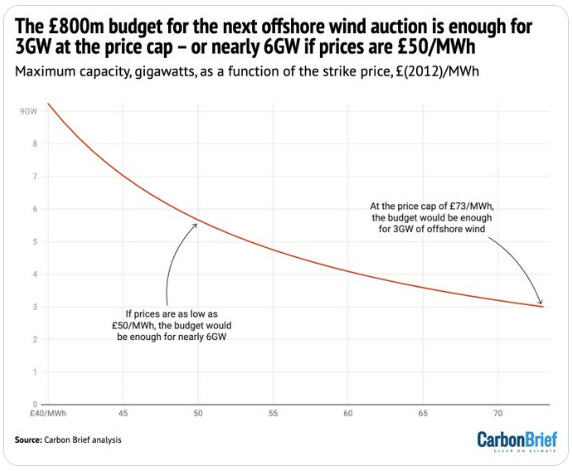How the Government is gaslighting us about offshore wind costs
The offshore wind schemes that will be given contracts by the Government this year will cost the public a great deal less than the budget implies and might even save consumers' money
On March 6th, in the Budget, the Chancellor announced what amounts to one the greatest pieces of energy gaslighting that I can ever remember (and that is saying something!). Jeremy Hunt claims that the Government is set to subsidise offshore wind to the tune of £800 million. In reality, the offshore wind schemes that will be awarded contracts (that will pay guaranteed prices for electricity output) will cost the consumer very little, and might even save them money. It is monumentally ridiculous to claim that the Government will spend anything approaching £800 million of its published budget supporting offshore wind. That is, given the electricity price projections for the future.
That’s because the Government calculates the amount of subsidy required to support the prices paid to offshore wind generators based on a batshit crazily low estimate of future wholesale electricity prices. Subsidies will make up the difference between this batshit crazily low price (henceforth referred to as BCLP) and the actual amount the generators get paid. If the actual wholesale power price from 2028 (when the schemes can get going) is a lot higher than this BCLP then the subsidies paid to the generators will be a lot lower.
The subsidies will be a lot lower - probably next to nothing, or less than nothing in fact. Cornwall Energy projected (HERE) that wholesale power prices will be approximately £90-£98 per MWh in the 2028-2030 period. Power prices are set by the highest-price generators which are gas-fired power plants.
But, hang on, the BCLP estimated by the Government is (in today’s money) £34-£42 per MWh during this 2028-2030 period. There’s a massive difference between these figures and the ones projected by Cornwall. The most that the Government will be paying the offshore wind generators is £102 per MWh (in today’s money). So the amount of subsidy required for offshore wind is based on the difference between this BCLP figure and the £102 per MWh. BUT, you can see that if Cornwall’s projections are correct then the amount of subsidy doled out to the new offshore wind schemes will be only a small fraction of the notional £800 million supposedly set aside by our kind Mr Hunt yesterday.
Projections of how much offshore wind will be given contracts vary according to how low the offshore wind developers will bid relative to the Government’s reference price (£73 per MWh in 2012 money or £102 per MWh in today’s money). Simon Evans of Carbon Brief estimates that this could be between 3GW and 6GW. He has kindly given me permission to reproduce his chart below showing how much offshore wind there will be according to different prices offered by developers (expressed in 2012 prices).
See HERE for Evans’ budget analysis.
Analysts told Business Green that they were doubtful that the next Government allocation round (called AR6) would deliver enough offshore wind to meet the government’s target of 50 GW of offshore wind by 2030. It would be even less likely to help an incoming Labour Government achieve close to 100 percent low-carbon electricity by 2030. RenewableUK, the trade body, says that there is a little over 10GW of offshore wind ready to go - that would be more like what is necessary to achieve Government targets.
Of course, there is no reason why we could not give out 10 GW of offshore wind contracts this year. It is likely, in reality, to cost consumers very little, and might actually save them money, depending on how low the offshore wind developers bid and how high power prices go in the future. Of course, the Government could give out a lot of onshore wind and solar contracts, which are now coming in cheaper than offshore wind, which definitely will save consumers a lot of money.
So why is the Government carrying out this astonishing piece of gaslighting? The most obvious answer perhaps is that the Government can claim to be giving a lot of money for green energy when in fact it is giving nothing, or at most very little. There are more conspiratorial theories, but I’ll leave it at that for the moment!
But certainly, if an incoming Labour Government had any sense it would tell the Treasury to go and stick their batshit crazy low price (BCLP) estimates for future wholesale electricity in some filing cabinet and use some realistic figures instead. In which case, yes, Ed Miliband can drive us reasonably close to achieving 100 percent of our electricity from low-carbon energy.
Check out my forthcoming book 'Energy Revolutions - profiteering versus democracy' (Pluto Press) by David Toke. Pre-publication order discount offered to YOU! (as someone who gets this newsletter!).
This book shows how we can move forward to an energy system powered by renewable energy rather than nuclear power or ‘carbon capture’ fossil fuels. It reveals how selective public ownership and targeted interventions, as part of an energy democracy programme will protect consumer interests better than the chaotic energy supply system that failed consumers so expensively in the recent energy crisis. We want no more of that!
Just quote the discount code 'TOKE30' - which will take 30% off the paperback and ebook up to the publication date. You can read more details and make a pre-order HERE.





Interesting article with contradictions surely given we are told renewables will lower our bills but to make them look good we need a high gas price!
Also governments don't give the subsidy consumers do through their bills.
Anyhow your posts are thought provoking.